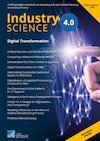Search


Bibtex
Cite as text
@Article{Schnelle+Schöpper+Kersten,
Cite-key = "Schnelle2023Dez",
Year= "2023",
Number= "1",
Volume= "Industry 4.0 Science 39",
Pages= "72-79",
Journal = "Industry 4.0 Science",
Title= "COVID-19: A Catalyst for Digitalization and Transparency? A Study on the Effects of the Pandemic",
Author= "Johannes Schnelle, Henning Schöpper and Wolfgang Kersten,
Hamburg University of Technology",
Doi= "https://doi.org/10.30844/I4SE.23.1.72",
Abstract= "The COVID-19 crisis had an unmistakable impact on the procurement situation in global supply chains, to which companies had to adapt quickly. The effects make it clear that to reduce risks, companies must address the structure and transparency of supply chains. The following article examines what knowledge the actors have and how digitalization can lead to further improvement. The results show that companies currently have
little supply chain knowledge beyond their direct suppliers, but are increasingly able to obtain the supply chain data they require. At the same time, the results indicate that there is still potential to increase transparency and the use of data.",
Keywords= "Corona, coronavirus, COVID-19, supply chain, digitalization, transparency, SMEs, supply chain transparency, demand forecasting, offshoring, supply chain digitalization",
}
Johannes Schnelle, Henning Schöpper and Wolfgang Kersten,
Hamburg University of Technology(2023): COVID-19: A Catalyst for Digitalization and Transparency? A Study on the Effects of the Pandemic. Industry 4.0 Science 391(2023), S. 72-79. Online: https://doi.org/10.30844/I4SE.23.1.72 (Abgerufen 13.11.25)
Open Access
Abstract
Abstract
The COVID-19 crisis had an unmistakable impact on the procurement situation in global supply chains, to which companies had to adapt quickly. The effects make it clear that to reduce risks, companies must address the structure and transparency of supply chains. The following article examines what knowledge the actors have and how digitalization can lead to further improvement. The results show that companies currently have little supply chain knowledge beyond their direct suppliers, but are increasingly able to obtain the supply chain data they require. At the same time, the results indicate that there is still potential to increase transparency and the use of data.
Keywords
Schlüsselwörter
Corona, coronavirus, COVID-19, supply chain, digitalization, transparency, SMEs, supply chain transparency, demand forecasting, offshoring, supply chain digitalization
References
Referenzen
[1] Handfield, R. B.; Graham, G.; Burns, L.: Corona virus, tariffs, trade wars and supply chain evolutionary design, IJOPM, aheadof-print, 2020.
[2] Klös, H.-P.: Nach dem Corona-Schock: Digitalisierungspotenziale für Deutschland, 2020, IW-Policy Paper 14/2020.
[3] Raehlmann, I.: Corona! Die Krise der Verschlankung und ihre Folgen (ger). In: Zeitschrift fur Arbeitswissenschaft, 2020, pp. 1-6.
[4] Kraftfahrtbundesamt: Fahrzeugzulassungen im September 2020: Pressemitteilung No. 23/2020. URL: www.kba.de/Shared-Docs/Pressemitteilungen/DE/2020/pm_23_2020_fahrzeugzulassungen_09_2020_pdf.pdf?__blob=publicationFile&v=4, accessed Nov 24, 2020.
[5] Ankel, S.: Trucks are forming 37-mile-long queues at European borders after authorities started closing them to stop the coronavirus spread. URL: www.businessinsider.com/coronavirus-europe-borders-shut-trucks-traffic-jam-2020-3?r=DE&IR=T, accessed Nov 24, 2020.
[6] Bauer, I. et al.: Transport and logistics barometer: 2020 mid-year analysis of M&A deals, joint ventures and strategic alliances in the transport and logistics industry. URL: www.pwc.de/de/transport-und-logistik/transport-and-logistics-barometer-h1-2020.pdf.
[7] BIEK: Rekord-Weihnachten: 420 Millionen Sendungen an Privatpersonen erwartet. URL: www.biek.de/presse/meldung/rekord-weihnachten-420-millionen-sendungen-an-privatpersonen-erwartet.html, accessed Nov 24, 2020.
[8] Ponomarov, S. Y.; Holcomb, M. C.: Understanding the concept of supply chain resilience, International Journal of Logistics Management, Vol. 20, No. 1, 2009, pp. 124-143.
[9] van Hoek, R.: Research opportunities for a more resilient post-COVID-19 supply chain – closing the gap between research findings and industry practice, IJOPM, Vol. 40, No. 4, 2020, pp. 341-355.
[10] Scholten, K.; Schilder, S.: The role of collaboration in supply chain resilience, Supply Chain Management, Vol. 20, No. 4, 2015, pp. 471-484.
[11] Wilding, R.; Dohrmann, K.; Wheatly, M.: Post-Coronavirus Supply Chain Recovery: The Journey Towards the New Normal. URL: www.dhl.com/content/dam/dhl/global/core/documents/pdf/glo-core-post-covid-eme-white-paper.pdf, accessed Nov 24, 2020.
[12] Roscoe, S.; Skipworth, H.; Aktas, E.; Habib, F.: Managing supply chain uncertainty arising from geopolitical disruptions: evidence from the pharmaceutical industry and brexit, IJOPM, aheadof-print, 2020.
[13] Hippold, S.: 6 Strategies for a More Resilient Supply Chain. URL: www.gartner.com/smarterwithgartner/6-strategies-for-a-more-resilient-supply-chain/, accessed Sept 3, 2020.
[14] Falk, S. et al.: Corona und die Folgen: Zehn Thesen zur Zukunft digitaler Geschäftsmodelle für Industrie 4.0 in der Post-Corona-Ökonomie. URL: www.plattform-i40.de/PI40/Redaktion/DE/Downloads/Publikation/Corona_Thesen.pdf?__blob=publicationFile&v=5 , accessed Sept 21, 2020.
[15] Kersten, W.; von See, B.; Lodemann S.; Grotemeier, C.: Trends und Strategien in Logistik und Supply Chain Management – Entwicklungen und Perspektiven einer nachhaltigen und digitalen Transformation, BVL.digital GmbH, 2020.
[16] Farrell, D.: Offshoring: Value Creation through Economic Change, Journal of Management Studies, Vol. 42, No. 3, 2005, pp. 675-683.
[17] OECD: Offshoring and Employment: Trends and Impacts, 2007.
[18] Heim, E.; Matiz, D.; Ehrat, M.: Offshoring oder Reshoring?, ZWF, Vol. 109, No. 12, 2014, pp. 920-922
[19] Tatzenko, J. et al.: The 2019 Ethical Fashion Report: The Truth Behind the Barcode. URL: https://apo.org.au/sites/default/files/resource-files/2019-04/apo-nid229606.pdf, accessed April 24, 2020.
[20] The Sustainability Consortium: Greening Global Supply Chains: From Blind Spots To Hotspots To Action. Impact Report. URL: www.sustainabilityconsortium.org/tsc-downloads/greening-global-supply-chains-from-blindspots-to-hotspots-to-action/?wpdmdl=19769&ind=1501155000091, accessed April 24, 2020.
[21] Nooraie, S. V.; Mellat Parast, M.: A Multi-Objective Approach to Supply Chain risk Management: Integrating Visibility with Supply and Demand Risk, Int J Prod Econ, Vol. 161, 2015, pp. 192-200.
[22] Yu, M.-C.; Goh, M.: A Multi-Objective Approach to Supply Chain Visibility and Risk, European Journal of Operational Research, Vol. 233, No. 1, 2014, S. 125-130.
[23] Choi, T. Y.; Linton, T.: Don’t let your Supply Chain Control your Business, Harvard Business Review, Vol. 12, No. 89, 2011, pp. 112-117.
[24] Schöpper, H.; Lodemann, S.; Dörries, F.; Kersten, W.: Digitalisierung deutscher KMU im Branchenvergleich, I40M, Vol. 2018, No. 2, 2018, pp. 38-42.
[25] DVZ Redaktion: „Der ökonomische Antrieb der Globalisierung bleibt sehr stark“. URL: www.dvz.de/rubriken/land/detail/news/der-oekonomische-antrieb-der-globalisierung-bleibt-sehr-stark.html, accessed May 5, 2020.

 English
English